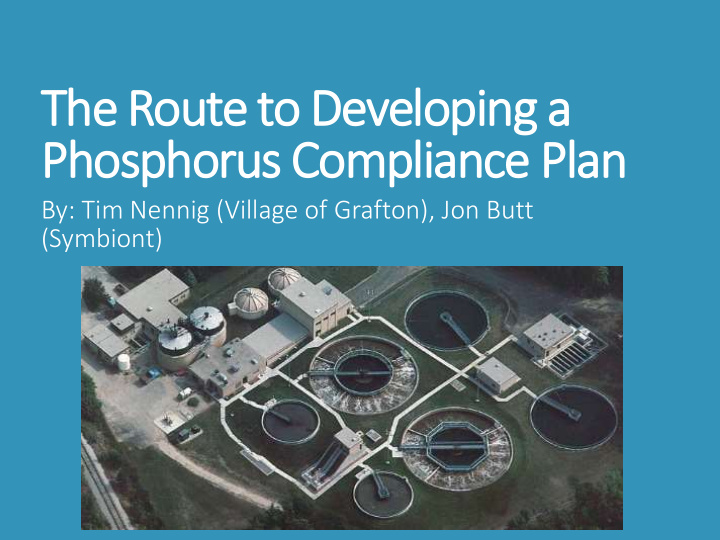



The Route to Developing a Phosphorus Compliance Plan By: Tim Nennig (Village of Grafton), Jon Butt (Symbiont)
Agenda 1. Background 2. WPDES Permit Requirements 3. Preliminary Alternatives 4. The final plan 5. Next steps
Background – Village of Grafton • Established: 1896 • Location: Ozaukee County, 20 miles north of Milwaukee • Population: 11,459 (2010) • Early Industries: • Furniture • Brewery • Cheese • Lumber • Geography: • Milwaukee River
Background – Grafton WWTP • Built: 1958 • Last Upgrade: 2005 • Average Flow: 1.50 gpd • Design Flow: 2.50 gpd • Type: Activated Sludge • Twelve (12) sewage lift stations • 54 miles sanitary sewers Gr Grafton WWTP
Background – Grafton WWTP
WPDES Permit Requirements • Permit issued: Newly issued September 2019 • Milwaukee River TMDL TP Allocations: Total Phosphorus Daily Monthly Days per Month Average Mass (lb) Month (lb/day) January 91.29 31 2.94 February 95.53 28 3.41 March 87.07 31 2.81 April 88.55 30 2.95 May 96.38 31 3.11 June 96.49 30 3.22 July 86.83 31 2.80 August 84.04 31 2.71 September 86.50 30 2.88 October 72.21 31 2.33 November 88.49 30 2.95 December 82.55 31 2.66 Annual Limit 1,055.94
Existing Conditions
Background – Wastewater Effluent TMDL Compliance
Preliminary Alternatives 1. 1. Treatment Plan lant Im Improvements 2. 2. Nutr trie ient Tradin ing 3. 3. Adaptiv ive management 4. 4. Multi lti-Dis ischarger r Varia iance (MDV)
Let’s start with - MDV • Is the Village Eligible? • The Village has an existing treatment plant • The Village must upgrade with tertiary filtration of the equivalent to meet the WQBEL • The Village is facing significant Capital improvements associated with a 35-year-old treatment plant but future sewer rate increases can not be included in the financial analysis – sewer rates with improvements for TP WQBEL compliance < 1% of the MHI • No – The Village is not eligible
How about Nutrient Trading? • The Village needs 1,532 lb/yr without any changes to the WWTP • Or, the Village could reduce the need to 268 lb/yr if a small WWTP project were completed • Where to supply the need?
Up Up-river Agricultural Sources Acres of Baseline P Ag type Type of Ag % of Land Operation (acres) (lb/yr) Cash Grain 40% 10,000 70,066.6 Dairy 40% 10,000 30,672.9 CAFO 20% 5,000 20,325.0 Total 25,000 121,064.5
Looks promising except Ag non-point sources need to achieve 85% to 90% reductions to meet TMDL obligations Long term trades possible on the remaining 10 to 15%. 100% Phosphorus reductions only possible if land is removed from production (Baker Cheese trade) Trading does not appear viable until more clarification is provided on trading within TMDL areas.
What’s left? • Treatment Plant improvements or Adaptive Management? • • Treatment Plant Adaptive improvements Management • • Capital $3.8 M Annual spend $200K to $400K – depending on • O&M $270K/yr the year • PV > $7M • There is annual O&M - • No turning back $30K/yr • Does not address MS4 • Best case PV > $3.35M • Easy to do • MS4 can be included • Lots of Unknown • Many options – you can change your mind!
Winner is – Adaptive Management • In the end, the Village felt: • 1. The in-river TP concentration is 0.01 mg/L over the criteria – it is worth it a try to see if it can be lowered • 2. The Village can always switch to treatment plant upgrades or trading • 3. There is an active Watershed group that can help the Village • 4. The Village plans to use an administrator to implement the plan • 5. The Village can apply for funding to help reduce the cost to the Village
So what’s the plan? • Ass ssis ist the County with ith im improvements to Mole le Creek • Install BMP’s along the Milwaukee River within action area • Install ag BMP’s up -riv iver r from the actio ion area • In Invest in in sm small ll im improvement to th the WWTP TP
Action Area & Monitoring Plan
Reduction Targets Reduction Target Location Lb/yr Mole Creek & Milwaukee River within 1,000 the action area Milwaukee River upstream from action 5,160 area Treatment Plant 1,280 Total 7,440
The Village has already started The Village has committed up to $5,000 per farm up to 4 farms to: Plant cover crops in the fall of 2019 To practice no till The Village has pledged this support for 2019-2020 and 2020- 2021. This work is being done in conjunction with Ozaukee County and the Milwaukee River Watershed Clean Farm Families.
The plan will be iterative … Make an improvement Analyze the data Collect Data
The goal • Return the River TP concentration to WQ criteria at as low a cost to the Village rate payers as possible
What’s next? • The Village will submit the AM plan with the permit renewal application • The Village will begin water monitoring program in May 2020 • The Village will complete the first year of funding ag partners Spring 2020 • The Village expects to advance some small projects within the action area throughout 2020
Recommend
More recommend